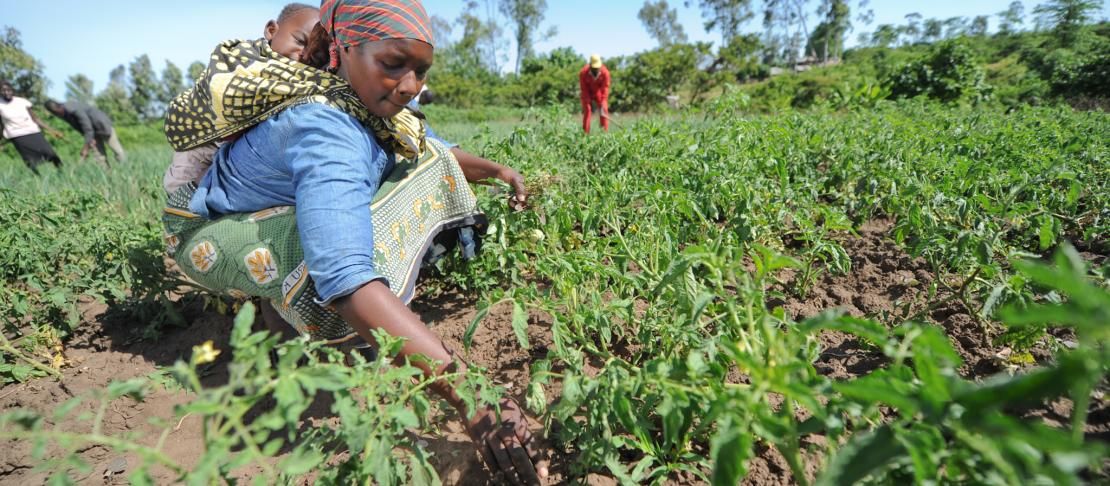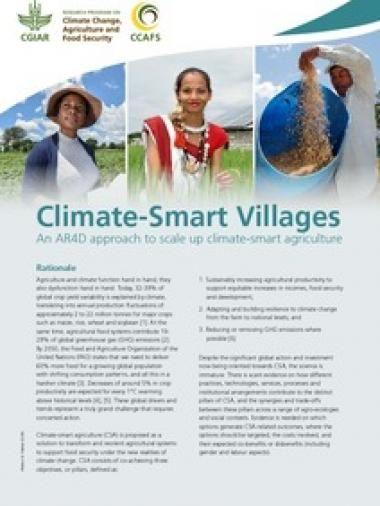Climate-Smart Villages give farmers options for a climate-smart future

Since 2012, participatory action research activities of the CGIAR Research Program on Climate Change, Agriculture and Food Security (CCAFS) have focused on identifying and testing locally relevant portfolios of climate-smart agriculture (CSA) options to help smallholder farmers overcome climate-related challenges.
In order to improve the adaptive capacities of communities and seeking to address the need for proven and effective location-specific CSA options in the context of climate change, to fill knowledge gaps and stimulate their scaling, CCAFS and partners developed the Climate-Smart Village (CSV) approach. Additionally, CSVs are considered as sites dedicated to generating key lessons for policymakers from subnational to global levels and for much wider CSA scaling.
But to what extent farmers involved in the CSVs have adopted and implemented CSA options? Is the CSV approach actually leading to efficient and positive socio-economic and biophysical changes? A monitoring tour organized in East and West Africa in 2019 by a CCAFS/the Alliance of Biodiversity and CIAT helped to address these issues.
What is the Climate-Smart Village approach ?
The CSV agricultural research for development (AR4D) approach is founded on the principles of participatory action research for grounding research on appropriate and location/context-specific enabling conditions, generating greater evidence of CSA effectiveness in a real-life setting and facilitating co-development of scaling mechanisms towards landscapes, subnational and national levels
Key features of the CSV approach
- Sites for testing, through participatory methods, technological and institutional options
- Sites where climate change in its broadest context is considered, but in relation to local realities: long-term adaptation, avoiding maladaptation, climate risk management, low emissions development
- Embodies a holistic vision for climate change action – not a silver bullet approach
- A platform for socially inclusive, multistakeholder collaborative work
- Founded on the principle of bringing CSA to scale
- Links global and local knowledge
Monitoring and evaluation for climate-smart agriculture
As part of its Learning Platform 2 “Participatory evaluation of CSA practices and technologies in Climate-Smart Villages”, CCAFS' Climate-Smart Technologies and Practices Flagship has developed the CSA Monitoring Plan.
This monitoring plan supports a global, systemic and standardized effort to build context-specific evidence on CSA adoption trends and drivers across diverse CSV sites and on CSA-related outcomes at household and farm levels. Overall, it aims to enable better understanding on the extent to which farmers' implementation of CSA options might lead to positive socio-economic and biophysical changes.
WHAT ARE THE MOST EFFICIENT CLIMATE-SMART AGRICULTURE OPTIONS IN DOYOGENA AND KAFFRINE?
In Doyogena (Ethiopia) and Kaffrine (Senegal), the activity allowed to analyze and determine the most impactful climate-smart options from agricultural producers involved in CSVs in both countries. Data was collected through a tool developed by the Alliance of Biodiversity International and the International Center for Tropical Agriculture, which allows users to evaluate the effect of these practices on producers' farms, taking into account the three pillars of CSA: productivity, mitigation and adaptation.
140 households (227 individual farmers: 137 male and 140 females) were surveyed in Doyogena (Ethiopia) while the monitoring survey covered 378 individual farmers: 191 males and 187 females in Kaffrine. In Doyogena , eleven promising CSA options targeting the rehabilitation of degraded landscapes and ecosystems, and the enhancement of farmer resilience were addressed:
- Terraces with Desho grass and water conservation measure,
- Controlled grazing,
- Improved wheat seeds (high yielding, disease-resistant & early maturing),
- Improved bean seeds (high yielding),
- Improved potato seeds (high yielding, bigger tuber size),
- Cereal/potato-legume crop rotation,
- Residue incorporation of wheat or barley,
- Green manure: vetch and/or lupin during off-season,
- Improved breeds for small ruminants,
- Agroforestry, and
- Cut and carry for animal feed.
On the other hand, in Kaffrine (Senegal) seven promising CSA options were considered as most promising. Those options included:
- Tree planting,
- Farmer-managed natural regeneration,
- Drought-tolerant improved varieties of millet, maize or groundnut,
- Reduced tillage,
- Manure use combined with microdose of inorganic fertilizer of Nitrogen, Phosphorus and Potassium (NPK) and urea,
- Microdose of inorganic fertilizer of NPK and urea, and
- Organic fertilizer.
Since 2019 this initial work has been fostered by the project “Building livelihoods and resilience to climate change in East & West Africa” co-funded by the European Union (EU) and the International Fund for Agricultural Development (IFAD). The project seeks to support large-scale adoption of climate-smart agricultural technologies and practices.
EFFECTS LINKED TO CLIMATE-SMART IMPLEMENTATION
Synthesis highlighted in an Info Note presents an analysis of the results from the 2019 implementation of the Climate-Smart Agriculture (CSA) Monitoring framework in Kaffrine (Senegal).
These results provided valuable insights for assessing the level of farmers adoption of these promising CSA practices as well as their perceptions on the effects of those practices on productivity, livelihood and food security, adaptive capacity and details related to gender dimensions.
As an example the study in Kaffrine indicates that farmers’ had positive perceptions regarding the effects of CSA practices on generating additional incomes, enhancing food access and diversity, improving climate resilience and not increasing agricultural labor time (on average 90% of adopting farmers). The effect on improving yields differed between male and female and among specific CSA-practice.
Findings also shows that about 2/3 of the households (HH) in the same area had reduced agricultural income in the year 2019, mostly due to climate-related shocks. Those impacts were higher for female-headed households (75%). About 20% of HH made changes in their cropping activities and 8% in their livestock activities. Female-headed HH, however, made more frequent changes (75% in crops and 50% in livestock), compared to male-headed HH (16% and 5% respectively).
In the Doyogena site covered by the monitoring, the study showed that farmers had positive perceptions regarding the effects of CSA practices on improving yield, generating additional income, enhancing food access and diversity and climate resilience. Due to learning and training, farmers involved into the CSV process have been able to increase their adaptive capacity, 100% of male-headed and 82% of femaleheaded HH implemented CSA practices and reported that they systematically improved yields, income, food access/diversity as well as resilience to climate shocks.
The study considers that knowing specific information on factors determining adoption and gender-related gaps provides valuable information for tailoring the design of future interventions aiming at scaling CSA as a path toward improved and “climate proofed” livelihoods.
Since 2019 this initial work has been fostered by the project “Building livelihoods and resilience to climate change in East & West Africa” co-funded by the European Union (EU) and the International Fund for Agricultural Development (IFAD). The project seeks to support large-scale adoption of climate-smart agricultural technologies and practices.
Dansira Dembélé is the Regional Communications Specialist for CCAFS West Africa

